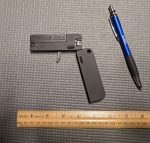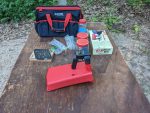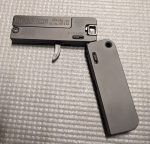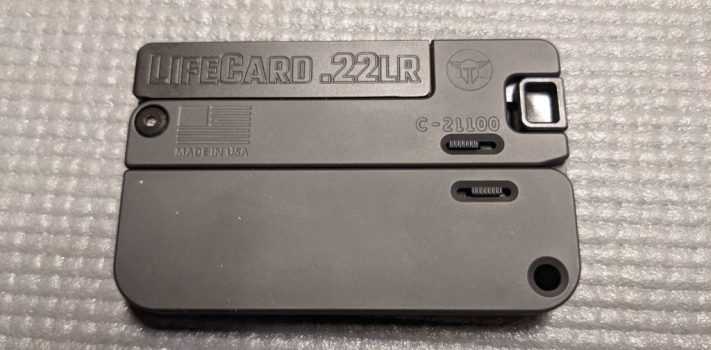The Trailblazer Firearms LifeCard is the ultimate in the “concealed” aspect of concealed carry. It folds into a tiny 3.38 x 2.06 x 0.5-inch package that looks something like a small cell phone, pager, or other electronic device. It unfolds into a diminutive derringer-style, single-shot handgun. It is a lot of fun to play with, and that is what I recommend it for: as a range toy and novelty. It has significant limitations as a tool for self-defense. But even the most limited tool that someone will actually carry with regularity is more helpful than a better tool that is left back at home in the gun safe.
Background
I have seen advertisements and read reviews for the LifeCard for a number of years now. It seemed like such a clever and fun idea that I wanted to give it a try. I contacted Trailblazer Firearms, and they were kind enough to provide me with a sample for testing and evaluation. A little more than a week later, a small (approximately 6.9 x 5 x 1 inches) box arrived at my FFL.
Opening the Box
The outside of the box indicated that the LifeCard is made in the U.S.A., and that Trailblazer Firearms is veteran owned.
 Inside, the box contained a simple quick-start-guide with four illustrated steps: open, load, shoot, and close. The box also contained the LifeCard, a lock, a manual, and a Trailblazer Firearms sticker.
Inside, the box contained a simple quick-start-guide with four illustrated steps: open, load, shoot, and close. The box also contained the LifeCard, a lock, a manual, and a Trailblazer Firearms sticker.
The fit and finish on my sample was excellent. The trigger is a little heavy, but it breaks crisply. The sight is a groove along the top of the frame/barrel. I found that it was somewhat difficult for my aging eyes to acquire.
 The particular model that I tested was the aluminum-handled .22LR version with the unthreaded barrel. There are also versions available chambered in .22WMR, with polymer handles, and with threaded barrels, and with various combinations of the above-mentioned features.
The particular model that I tested was the aluminum-handled .22LR version with the unthreaded barrel. There are also versions available chambered in .22WMR, with polymer handles, and with threaded barrels, and with various combinations of the above-mentioned features.
At the time of this writing, the aluminum-handled .22LR version cost $349 at trailblazerfirearms.com. Other models ranged in cost from $299 to $369.
The manual is 24 pages long, not counting the inside and outside of the front and back covers. I noted a number of things from the manual:
∙ The state-by-state warning follow the title page. I recommend that Trailblazer Firearms move these warnings to the back of the manual. The bureaucratic legalese of the warnings is prone to induce narcolepsy in innocent readers before they can get to the meat of the manual.
∙ The safety guidelines warn the user not to decock the LifeCard by holding the recessed sides of the bolt and pulling the trigger. This means that the user is pretty much committed to fire the LifeCard once it is cocked.
∙ The LifeCard cannot be cocked or fired when the handle is closed around the trigger. Also, the handle cannot be closed fully when the LifeCard is cocked. This means that closing the LifeCard functions as a highly effective manual safety.
∙ There is a storage compartment in the handle with space for three extra rounds.
∙ Trailblazer Firearms recommends not dry firing the LifeCard. This is a common manufacturers’ recommendation for many rimfire firearms.
∙ There is a hole on top of the bolt for the padlock. The LifeCard cannot be fully closed when the padlock is in place.
∙ Cleaning the LifeCard does not require any disassembly. It is just a matter of opening the chamber, cleaning the bore and chamber, and wiping the rest of the accessible parts.
∙ The manual includes a nice exploded diagram and parts list. The LifeCard only has 20 parts including the lid to the storage compartment.
∙ The manual states that the LifeCard should not be carried with a round in the chamber. But it is pretty clear that the LifeCard was, in fact, designed to be carried with a round in the chamber. When the Life Card is folded up with a round in the chamber, there are two internal safety features that would prevent it from firing. First, the striker is at quarter-cock and blocked from being fully cocked. Second, the trigger is shrouded by the handle and cannot be pulled. The statement about not carrying the LifeCard with a round in the chamber is almost certainly included in the manual solely for liability reasons.
Range Testing
It was a warmish evening in late spring/early summer. The temperature was 83 degrees Fahrenheit. The air was still. There was a very thin, hazy cloud cover.
 I went to the improvised range behind my pole barn and set up a target stand in front of the backstop. Five yards away, I set up a table with a pistol rest. I set the table with the rest only five yards away for a number of reasons: the barrel of the LifeCard is only about 2.3 inches long, the sight is just a shallow groove along the top of the barrel, and the barrel is not rifled. I did not have high expectations for accuracy.
I went to the improvised range behind my pole barn and set up a target stand in front of the backstop. Five yards away, I set up a table with a pistol rest. I set the table with the rest only five yards away for a number of reasons: the barrel of the LifeCard is only about 2.3 inches long, the sight is just a shallow groove along the top of the barrel, and the barrel is not rifled. I did not have high expectations for accuracy.
The forest around our home is quite marshy in places, and the mosquitoes were out in force. I needed to wear a bug jacket to keep thick clouds of the voracious blood-suckers at bay. Mosquitoes are the deadliest animal known to mankind, spreading malaria, dengue, West Nile virus, yellow fever, and a host of other serious illnesses. Fortunately, most of those illnesses are not endemic to the area in which I live. So I wear a bug jacket primarily for my comfort rather than for my health.
The mosquitoes were so aggressive that I had to wear gloves to protect my hands, and the sound of their buzzing could be clearly heard even through the hearing protection that I was wearing.
I started out firing 5 rounds of Federal 38 grain copper-plated hollow point from rest. This is a fairly generic load that I often use to begin testing firearms chambered in .22LR.
It was somewhat difficult for my aging eyes to acquire the groove along the top of the barrel in the evening light. The LifeCard does not have an ejector, and I could not use my fingernails to extract the fired round since I was wearing gloves. I needed to remove spent casings with my EDC knife instead. My shots struck consistently high and to the right of my point of aim, and produced a group roughly 5.3 inches in size.
Next, I tried a 5-shot group with MaxxTech 40 grain LRN. This is a mild round, which is surprisingly accurate for cheap ammo. It produced a group roughly 4.2 inches in size.
Then I tried a 5-shot group with Browing 40 grain LRN. It produced a group roughly 3.5 inches in size.
A 5-shot group using Remington Bucket O’ Bullets 36 grain plated hollow point was next. It produced a group roughly 3 inches in size, with 3 of the shots being within a half inch of each other.
I used Remington Thunderbolts 40 grain LRN for the next five-shot group. It was approximately 2.5 inches in size.
Finally, I fired 5 rounds of Federal Auto Match 40 grain LRN. It produced a group approximately 3.5 inches in size.
These groups were nothing to brag about, but they could have been worse in light of the barrel length, rudimentary sight, and smooth bore issues mentioned above. The biggest problem was that all of these groups centered about 3 inches to the right and 2 inches above the point of aim shooting from 5 yards. Anyone planning to use the LifeCard for anything important will need to take the time to familiarize themselves with the “Kentucky windage” necessary to bring the point of impact in the near vicinity of the intended target.
I did notice that my groups generally tended to improve as I became more familiar with the LifeCard. Extra time spent with a particular handgun will generally contribute to improved performance.
Cleaning
 I can’t think of any firearm that is easier to clean than the LifeCard. I just needed to tip open the chamber, run a solvent patch through the bore, run a brass brush through the bore, run additional solvent patches through the bore until they come through clean, run a dry patch through the bore, run a solvent patch over the exterior metal surfaces, wipe the excess solvent off the exterior metal surfaces, and run a CLP patch through the bore and over the exterior metal surfaces.
I can’t think of any firearm that is easier to clean than the LifeCard. I just needed to tip open the chamber, run a solvent patch through the bore, run a brass brush through the bore, run additional solvent patches through the bore until they come through clean, run a dry patch through the bore, run a solvent patch over the exterior metal surfaces, wipe the excess solvent off the exterior metal surfaces, and run a CLP patch through the bore and over the exterior metal surfaces.
Wishes
It is said that “If wishes were horses, all beggars would ride.” I had several thoughts for “improvements” that may be impractical, but that are fun to think about.
The first “improvement” is that I would like to see a version of the LifeCard in stainless steel. One niche that I can see for the LifeCard is as a tackle box gun, and stainless construction would greatly enhance its corrosion resistance. Corrosion resistance is already pretty good, because many of the external parts are made of aluminum (or aluminum and polymer for the polymer-handled models).
The second “improvement” would be a set of small sights that fold into the front of the barrel and the back of the bolt. If at least one of the sights could be drifted for windage, it would greatly enhance the utility of the handgun.
The third “improvement” would be the possibility of locking the handgun while it is folded. If I had the gun in my tackle box, I would want it secured while I was fishing with my grandchildren.
The problem with these “improvements” is that they take an elegantly simple design and make it more complicated. Trailblazer Firearms is probably better off without my helpful suggestions.
Conclusions
The LifeCard in .22LR is a really fun concept that is also fun to shoot. It is not particularly accurate, and the .22LR cartridge is quite anemic for self-defense, especially out of a 2.3-inch barrel.
If you have friends over to shoot the LifeCard, they will have fun, and you won’t burn through very much ammo either. Reloading is a distinctly deliberate process.
If you already carry something else, I do not recommend switching to the LifeCard. If you would like to carry, but everything else is too big/bulky/conspicuous, then the LifeCard may be a viable option for you.
Disclaimer
Trailblazer Firearms was kind enough to provide me with a sample of their LifeCard in .22LR for testing and evaluation. I tried not to let their kindness interfere with my objectivity in this review, and believe that I have succeeded. I did not receive any other financial or other inducement to mention any vendor, product, or service in this article.










